AMD ATI Radeon HD 4770 Review
AMD ATI Radeon HD 4770
AMD ushers in the 40nm era with a cracking mid-range graphics card.
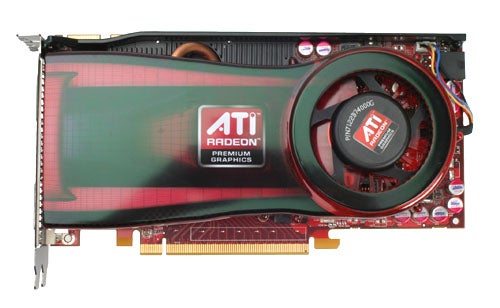
Verdict
Key Specifications
- Review Price: £78.12
The £200-£250 price range for graphics cards has been really exciting as of late with both the ATI HD 4890 and the nVidia GTX 275 providing oodles of performance for a great price. However, there’s no denying it, £200+ is still a huge amount to spend on a graphics card – especially when you can get an entire games console for that sort of money. So, if you only occasionally use your PC for gaming, have a small monitor, or just generally are a bit strapped for cash, the price ceiling is more like £100. In which case a prime candidate for your money should be this new card from ATI. 
The HD4770 is built around the RV740 GPU, which is the world’s first graphics chip to be built on a 40nm process, whereas most other cards from both ATI and nVidia currently use a 55nm process. This smaller manufacturing process makes for smaller transistors, meaning more can be fit into the same size piece of silicon. In the case of the RV740 it has 826million in a piece of silicon only 143mm^2. In contrast, the RV770 (as used by the HD4870 and HD 4850) uses the 55nm process and contains 965million transistors. The resultant slab of silicon is 267mm^2 – quite some difference, I’m sure you’d agree. 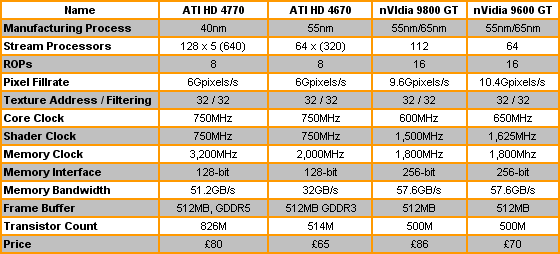
In terms of features, the HD4770 is based on the same architecture as the HD48x0 series, but with tweaks here and there to the amount it has of each constituent part. Namely, there are 128 five-way superscalar shader units that make for a total of 640 stream processors (twice that of the HD46x0 series and somewhat less than the 800 of the HD48x00 series) and 32 texture units. Accompanying these are 8 ROPs that use a 128-bit interface to talk to 512MB super fast GDDR5 memory. So, essentially, the HD4770, has nabbed a little bit from both the HD48x0 series and HD46x0 series and ATI has both priced and named the part accordingly – an observation that sounds obvious but, in the world of computer-part naming conventions, is something of a rarity.
Considering the basic architecture of the HD4770 is stuff we’ve covered before, we’ll keep our discussion of the technicalities to a minimum (check out our in-depth study of the 4xx0 series architecture if you’d like to learn more) and actually let our test results do the talking with regards performance.
The card itself surprised us at first as it uses a dual slot cooler, when much of the competition at this price point uses a single slot design. This isn’t necessarily a bad thing as dual slot designs generally run cooler and quieter, which indeed seemed to be the case here. However, if you want to use one of these cards in a small system like a media centre you may find the dual slot design is a deal breaker. At least the length of the card shouldn’t be a problem as it’s only 210mm long. 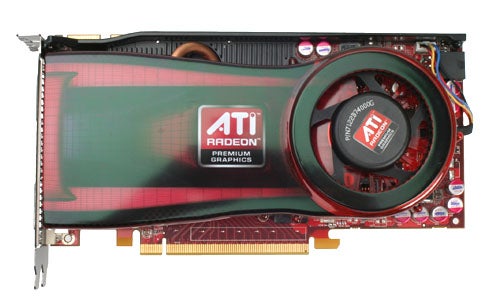
As mentioned, though, on the whole this card was incredibly quiet with it being whisper quiet when idling and for most of the time when under load as well. However, every now and again, the fan does spin up to full speed as the GPUs temperature reaches a certain point. The resultant noise is particularly off-putting with it taking on an almost howling overtone, on top of the strong whooshing noise. We’re quite sure this isn’t necessary, though, and ATI could make the fan kick in less drastically but retain the same thermal performance. Hopefully this is something that will either be sorted either in final retail boards, by a driver update, or by a firmware update. Also, it must be noted that plenty of other more high-end cards are just as noisy when under load, there’s just less of a drastic change. 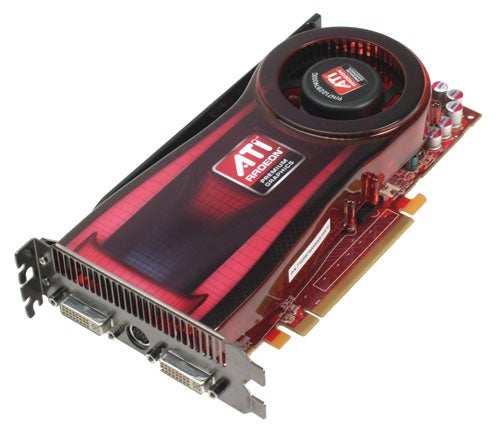
Another thing to note about the cooler is that none of the retail cards currently available seem to use the reference cooler. Instead they mostly seem to be using a design that doesn’t incorporate cooling for the memory and that doesn’t exhaust the hot air anywhere. Unfortunately we can’t comment on the efficacy of this cooler and we’re still waiting for a statement from ATI regarding this situation.
This card’s output configuration is the same we’ve seen on pretty much all graphics cards in the last several years. Two dual-link DVI sockets that support HDMI output, via dongles that are generally included in the box, flank an analogue output that natively acts as an S-Video output but, with the help of other dongles, can also output component and composite video. 
Likewise, there’s the now expected six-pin auxiliary power socket on the front edge. At peak ATI claims this board uses 80W, which is only 5W more than the power available straight from the PCI-Express slot, but to be safe ATI has opted to use the extra 75W available from the six-pin socket.
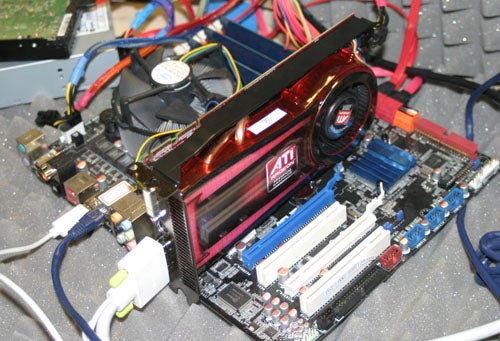
”’Test System”’
* Intel Core i7 965 Extreme Edition
* Asus P6T motherboard
* 3 x 1GB Qimonda IMSH1GU03A1F1C-10F PC3-8500 DDR3 RAM
* 150GB Western Digital Raptor
* Microsoft Windows Vista Home Premium 64-bit
”’Cards Tested”’
* ATI Radeon HD 4770
* nVidia GeForce 9800 GT
* nVidia GeForce 9600 GT
”’Drivers”’
* ATI HD 4770 – Beta Driver
* Other ATI cards – Catalyst 9.4
* nVidia cards – 182.08
”’Games Tested”’
* Crysis
* Race Driver: GRID
* Call of Duty 4
* Counter-Strike: Source
While it hasn’t been a huge commercial success and its gameplay is far from revolutionary, the graphical fidelity of Crysis is still second to none and as such it’s still the ultimate test for a graphics card. With masses of dynamic foliage, rolling mountain ranges, bright blue seas, and big explosions, this game has all the eye-candy you could wish for and then some.
We test using the 64-bit version of the game patched to version 1.1 and running in DirectX 10 mode. We use a custom timedemo that’s taken from the first moments at the start of the game, wandering around the beach. Surprisingly, considering its claustrophobic setting and graphically rich environment, we find that any frame rate above 30fps is about sufficient to play this game. All in-game settings are set to high for our test runs and we test with both 0xAA and 2xAA.
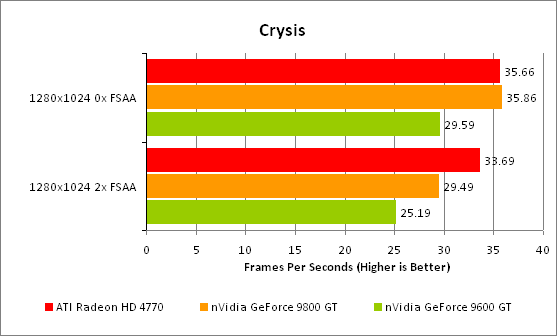
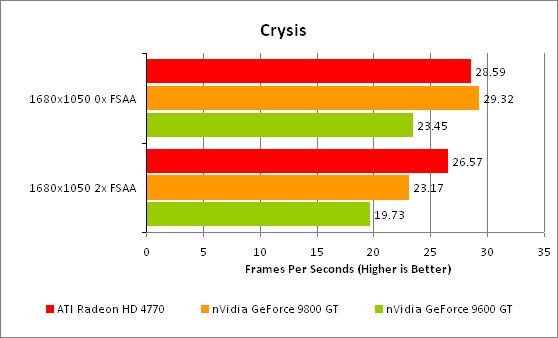
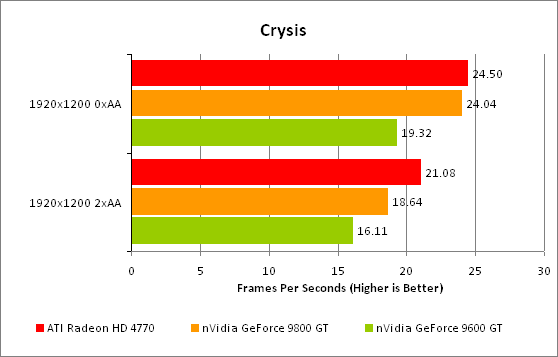
It’s a pretty close run thing but it’s clear that the ATI HD 4770 holds an advantage over its two closest rivals in this title. Admittedly, all the cards are borderline playable at these high settings but, even at 1,920 x 1,200, it would only take dropping a few in-game detail settings to reach a steady and playable framerate.
Race Driver: GRID is the newest game in our testing arsenal and it’s currently one of our favourites too. Its combination of arcade style thrills and spills with a healthy dose of realism and extras like Flashback makes it a great pick-up-and-go driving game. It’s also visually stunning with beautifully rendered settings, interactive crowds, destructible environments, and stunning lighting. All that and it’s not the most demanding game on hardware, either.
We test using the 64-bit version of the game, patched to version 1.2, and running in DirectX 10 mode. FRAPS is used to record frame rates while we manually complete one circuit of the Okutama Grand Circuit, in a Pro Tuned race on normal difficulty. We find a frame rate of at least 40fps is required to play this game satisfactorily as significant stutters can ruin your timing and precision. We’d also consider 4xAA as a minimum as the aliasing on the straight lines of track, barriers, and car bodies is a constant distraction. All in-game settings are set to their maximum and we test with 0xAA and 4xAA.
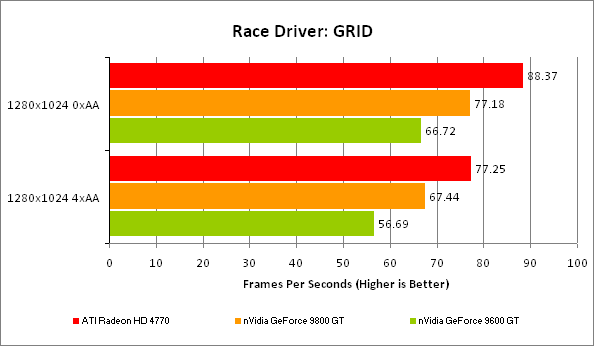
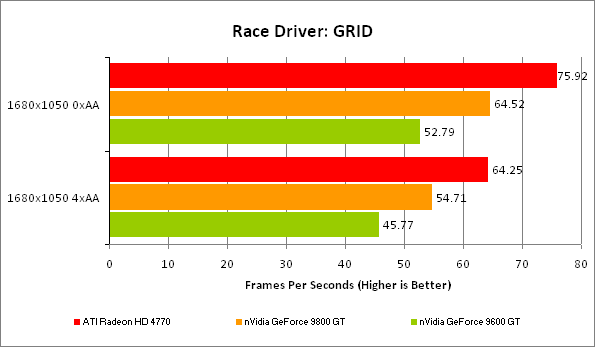
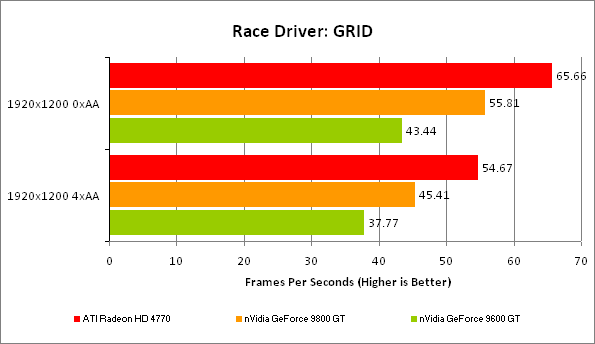
While all three cards again manage to achieve a playable framerate in most of our tests, ATI’s HD4770 has that much more headroom so would be the obvious choice at this price for this title.
What can we say about Counter-Strike: Source that hasn’t already been said before? It is quite simply the benchmark for team-based online shooters and, five years after its release, it’s still one of the most popular games in its genre. It focuses on small environments and incredibly intensive small-scale battles with one-shot kills the order of the day. If you want to test all elements of your first person shooter skills in one go, this is the game to do it.
We test using the 64-bit version of the game using a custom timedemo taken during a game against bots on the cs_militia map. This has a large amount of foliage and is generally one of the most graphically intensive maps available. We find a frame rate of at least 60fps is required for serious gaming as this game relies massively on quick, accurate reactions that simply can’t be compromised by dropped frames. All in-game settings are set to their maximum and we test with 0xAA 0xAF, 2xAA 4xAF, and 4xAA 8xAA.
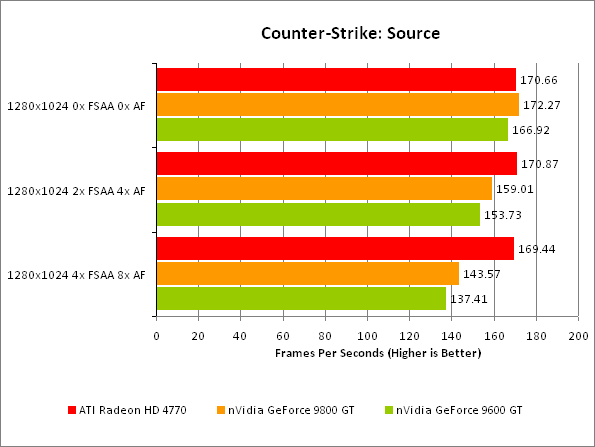
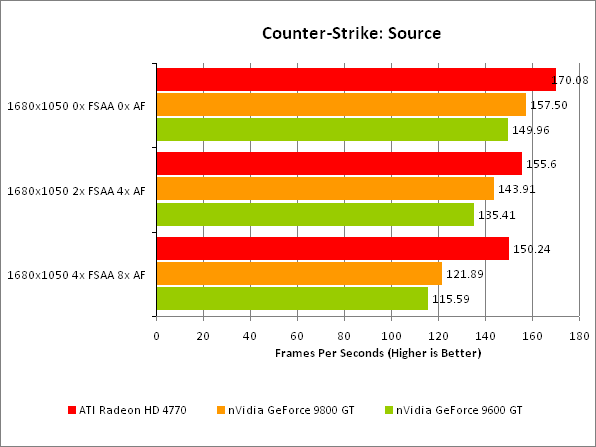
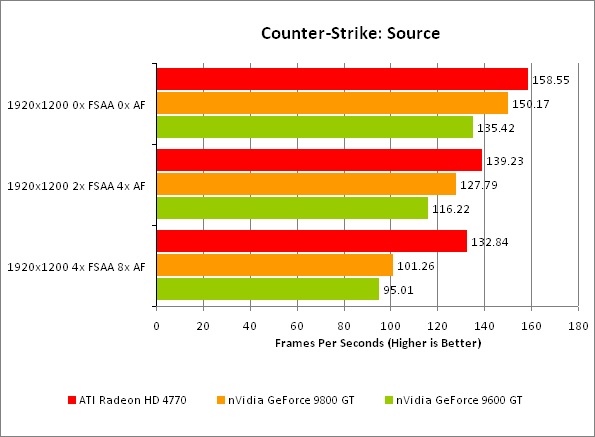
Here we see a good demonstration of why we continue to use this game in our testing. While all high-end cards absolutely blitz through all our tests, once we get down to mid-range cards there’s more of a discernible difference. It’s still not a significant difference in day-to-day play (though back in the day I did consider 100fps to be my preferred refresh rate when playing the original Counter-Strike). Regardless, the HD 4770 is the clear winner again.
Call of Duty 4 has to be one of our favourite games of 2007. It brought the Call of Duty brand bang up to date and proved that first person shooters didn’t need to have the best graphics, or the longest game time. It was just eight hours of pure adrenaline rush that constantly kept you on edge.
We test using the 64-bit version of the game patched to version 1.4. FRAPS is used to record frame rates while we manually walk through a short section of the second level of the game. We find a frame rate of 30fps is quite sufficient because, although the atmosphere is intense, the gameplay is less so – it doesn’t hang on quick reactions and high-speed movement. All in-game settings are set to their maximum and we test with 0xAA and 4xAA.
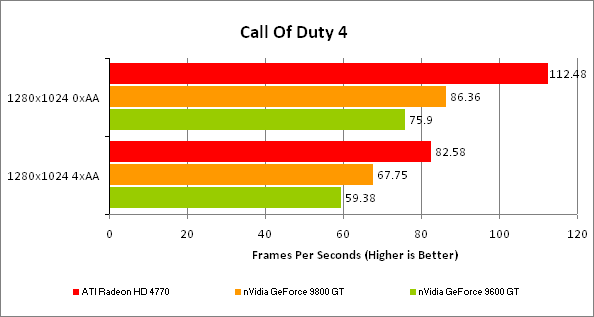
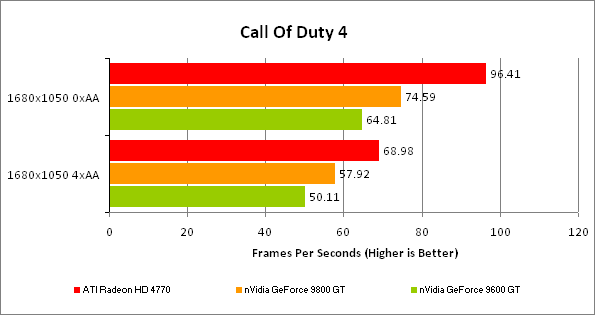
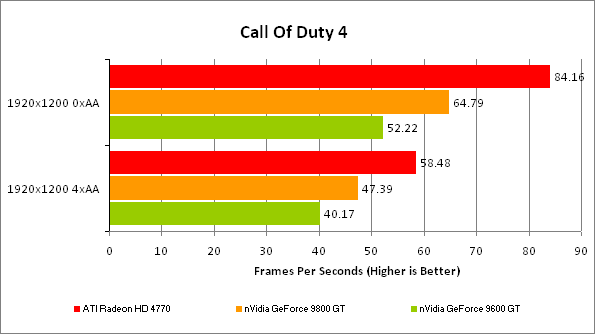
What has up until now been a somewhat academic difference in performance finally blossoms into a clearly discernible gulf between the HD 4770 and the 9800 GT and 9600 GT – the difference between the HD 4770’s 58.48fps and the 9800 GT’s 47.39 would be one most people would feel in everyday play.
Power is measured using a wall socket power meter so accounts for the whole system. Nevertheless it still clearly demonstrates the difference between the cards we have on test, and what a difference! Okay, at idle there’s not much of a difference between the three, but under load the 9600 GT starts to gobble up noticeably more power than the HD 4770. At first the 9600 GT appears to be doing fine as well but this is a slower card so the performance per watt is considerably worse than the HD 4770. 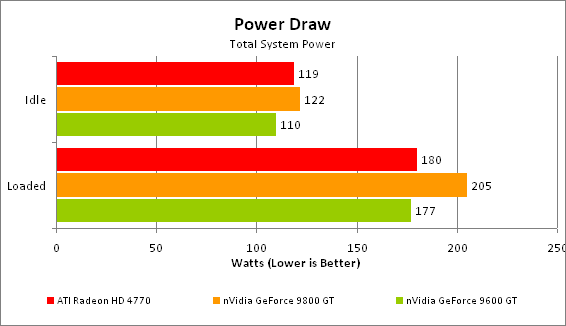
In theory the lower power usage, low operating temperature, and large cooler of the HD 4770 should enable it to be a good overclocker. This is something we quickly put to the test using the overclocking tool in ATI’s driver. Sadly the limits for core and memory clock speeds were 830MHz and 850MHz respectively. These amount to just 11 per cent and 6 per cent overclocks and resulted in our Crysis score at 1,920 x 1,200 (2xAA) improving by just 1fps to 22.64fps. Suffice to say, this is not particularly impressive and is easily equalled by the 9800 GT, but if ATI opens up the overclocking settings in its drivers or you use a third party application we think there should be plenty more headroom to play with.
More troubling than any overclocking worries, though, is the pricing of this card. While it compares well to those cards that are meant to be at this price point, there are rogue nVidia GTS 250 and HD 4850 cards (literally one of each in a few shops) hitting the £100 mark. At this price both these cards are an absolute steal and we’d recommend you stretch just a little and get one of them. We rather suspect the pricing will level out in the not too distant future, though, and the HD 4770 and 9800 GT will once again be left to battle it out in their own price point.
”’Verdict”’
The switch to a 40nm manufacturing process hasn’t exactly blown us away but nevertheless, in the HD 4770, ATI has produced a card that comfortably bests all others at its price point. So, if you’ve got about £80 to spend on a graphics card, the choice is clear.
Trusted Score
Score in detail
-
Value 8
-
Features 7
-
Performance 8

